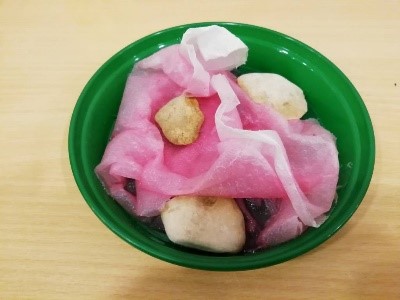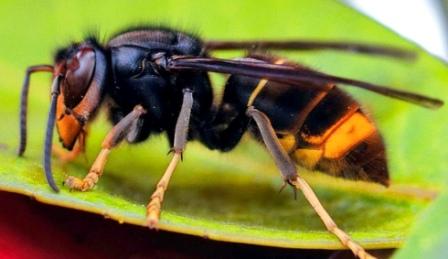The February edition of the Buzzette alerted members that monitoring across the SW region would take place during the last 2 weeks of April 2020. The agreed starting date for the SW region is Monday 13 April until Tuesday 30 April 2020.
The rationale for the spring monitoring is that fertilised (foundress) Queen Asian Hornets will be coming out of hibernation around this time when average daily temperatures are at 13oC or higher. They will be hungry and looking for a high carbohydrate feed during the primary nest building phase just prior to egg laying. Hence, they will be feeding from flowers which have a good nectar quality and replenishment cycle. Spring flowering Camelias have been most favoured on Jersey over other varieties but not exclusively. Tree sap is also a good source of foundress Asian Hornet nutrition notably oak, beech, maple and willow. Therefore, spring monitoring is to be conducted near forage sources not near beehives.
The Coronavirus rules are clear – stay at home, maintain social distancing.
Asian Hornet spring monitoring can be conducted in our gardens with the results communicated electronically – Coronavirus rules upheld.
Monitoring is not trapping. The ‘green bottle’ trap advocated on the BBKA / NBU sites is an indiscriminate killer of all flying insects. The ignoring of the amount of ‘by catch’ (non-target insects) cannot continue to go on unchallenged. With insect declines becoming more acute (40% worldwide over the last 10 years with 33% endangered; 75% loss in Germany over 26 year period), there is no justification for trapping.
Hence for this exercise two types of monitoring station are recommended. The wick model or the saucer model.

The wick model is easily made from a plastic container such as a 250ml butter tub and a rolled piece of J-cloth. Taking the clean tub make a horizontal slit in the centre of the lid approximately 5cm (2 inches) long. Fold a piece of J-cloth cut to a length of 10 to 12 cm (5-6 inches) a number of times just thick enough to go through the slit. Pull the cloth through the lid until approximately 2 cm is sticking out above the lid surface. The wick is placed inside the tub, a small amount of attractant poured in and the lid firmly pressed on. The tub is then placed approximately half a metre to a meter above the surface of the ground, an up turned bucket will suffice, near a Camelia bush or similar or tree sap source. For rainy days or windy conditions, a plastic sheet can be bent over the tub to keep the attractant wick functioning.

The saucer model is simplicity itself; use a clean plant pot saucer and put 3 or 4 scrunched up sheets of kitchen paper in it. Pour attractant solution in to wet all the paper without leaving a puddle of liquid in the saucer. Weight the paper down with a number of stones as these will stop the paper being blown away as well as provide landing zones for the insects to settle while they feed. Place the saucer on an upturned bucket or similar to raise off the ground near your monitoring plant area.
The Attractant
The BBKA and AHAT had identified and recommended that a commercially produced product “Suterra” (now re-branded as Trappit) be used. The branch had bought a supply for distribution to members in April although it is expensive £30+ for 5 litres. This distribution cannot now take place and so members will have to resort to a homemade recipe similar to that used in France.
The recipe for the attractant is approximately 50% by volume of cheap lager or sweet white wine and 50% by volume of sweet fruit syrup. In France, cassis is used but blackcurrant juice / squash is a suitable alternative. Other recipes are:
- 350ml of beer + 2 tablespoon of sugar or honey
- 200ml of water + 2 tablespoon of sugar or honey + a dash of vinegar (no more than 30ml)
- 350ml sweet white wine (or white wine sweetened with sugar) + 20 to 30 ml of mint or blackberry syrup
Monitoring
Asian Hornets do not fly at night and observations suggest that their flying time is most prevalent between 10:00 until 14:00 hours. Using a technique used by the Big Wasp Survey (University of Gloucester) and the Big Butterfly Count (Butterfly Conservation Society), pick 3 x 30minute periods during 10:00 to 14:00. Sit near the monitoring station (approximately 1 metre away) positioned so as not to cast a shadow over the station. Record insects for that 30 minute period. Asian Hornets are docile when feeding and so a photo can safely be taken or a specimen can be obtained by coaxing into a tube. Once in the tube, seal it and put it in a freezer for 24 hours to kill the Hornet.
Nb. It is an offence to contain / trap and then release an Asian hornet so once caught it is to be killed.
Remove the station at the end monitoring time and do not leave out overnight. Reposition in exactly the same spot for your next monitoring session unless a more fruitful position is found. This activity can be done every day, every other day or every 3 days whichever fits your lifestyle, it is important that it is done routinely so that the foundress comes to identify the food source as a permanent feature.
The location of your monitoring station needs to be accurate and the details able to be used by others for data collection purposes. A mobile phone app “What Three Words” has been used extensively by rescue organisations and the police to pinpoint locations. It is free to download (Apple and Android versions) and the unique code word generated identifies the precise square metre. Please use this app as our default location identifier.
I think I’ve spotted an Asian Hornet
Usually an email to the coordinator and a visit would be arranged and more monitoring would take place together with photographic evidence being obtained. This can no longer take place.
Currently, send the coordinator a photo of the insect that is causing concern. Verification of the photo will be promptly done by electronic conferencing between other committee members to arrive at a consensus identification. The reply email will inform the member if it is an Asian Hornet. At that point the member’s monitoring data will need to be sent to the Non-Native Species Directorate and the NBU – The Asian Hornet App (Android and Apple versions free) will help do this. The same data is to be also sent to the coordinator (ahat@tivertonbeekeepers.uk)
Once this information has been received and verified, the branch and the beekeeper will be advised as to the way forward especially during this pandemic.
The chances of spotting a foundress during this monitoring session are minimal. With Jersey having a nest density of 189 during 2019 the likelihood of hornet presence being detected is reasonably high – 2.6 nests per Km2. If the same density is applied to the Tiverton branch area (basically Mid Devon) then there would be 0.33 nests per Km2. The situation of one queen or nest being detected in the Tiverton branch area becomes 1 to 50Km2. Thus, although the chance of finding an Asian Hornet in the present circumstances is extremely low by being part of a bigger survey of the SW area the chances of detection are increased. When the Asian Hornet habitat includes Southern England then monitoring will become ever more important and a routine activity for DBKA members.
All monitoring data, including attractant recipe used and insects observed, is to be sent to the branch AHAT Coordinator so that a database can start to be compiled to help inform future policies and protocols as well as help individual members with their beekeeping .
Any correspondence regarding
the spring monitoring or Asian Hornets to be sent to ahat@tivertonbeekeepers.uk .
Gavin
Nuttall-Owen
AHAT Coordinator

